
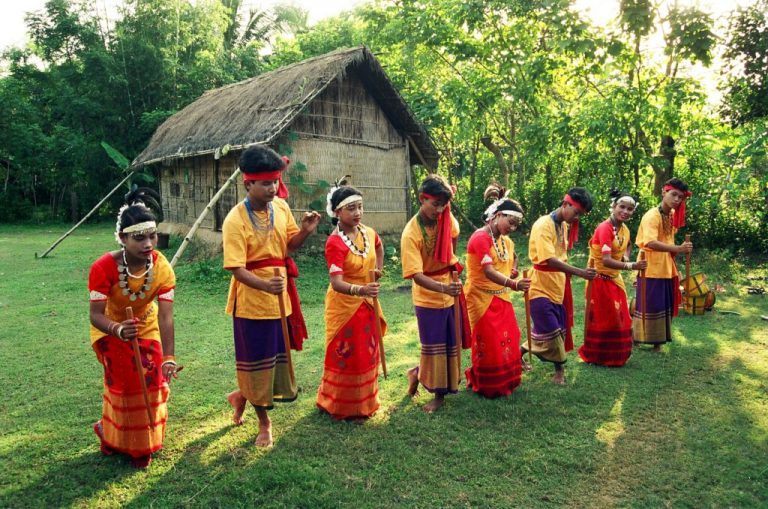

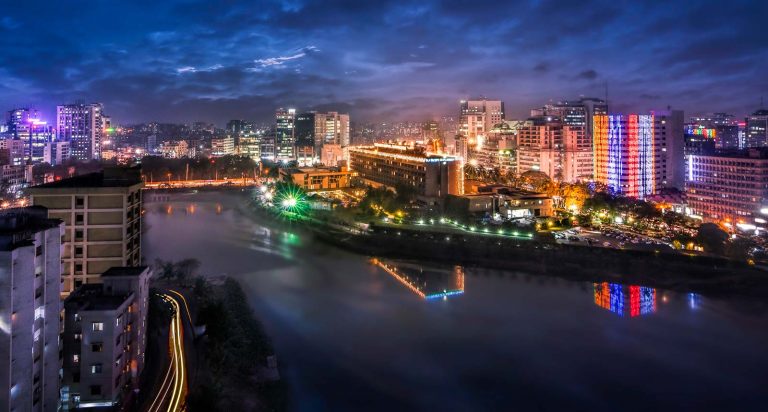
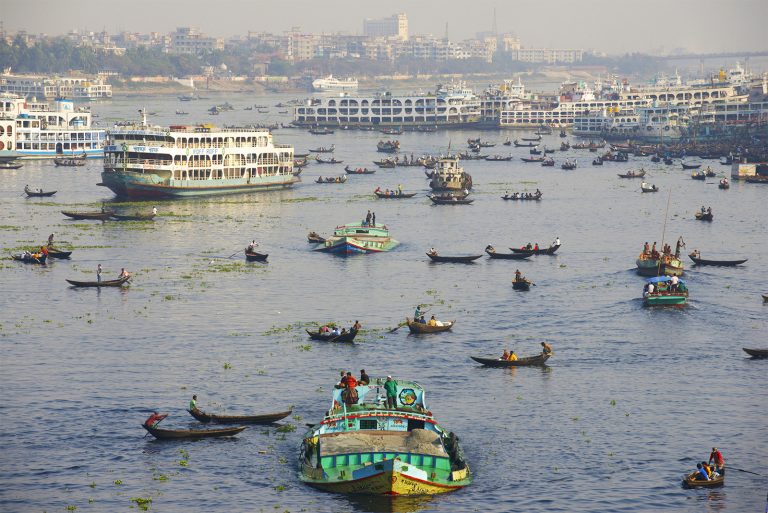
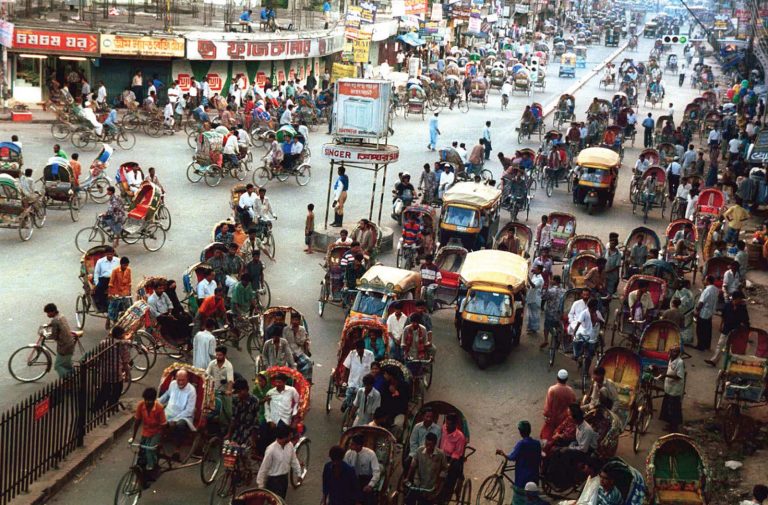
1 BANGLADESH | Raw Beauty
23 mei 2019
2 Wonderful rainy season in Bangladesh || village rainy day
Travel Bangladesh. Choose My Adventure 11.
26 jul. 2012
3 Epidemic of Child Marriage in Bangladesh
9 jun. 2015
4 Documentary : Life as a Char inhabitant in Bangladesh | Friendship Charity Bangladesh
11 jan. 2017
5 COVID-19 In Bangladesh: Will Government Aid Reach The Poor In Time? | Insight | Full Episode
21 okt. 2020
23 mei 2016
7 Dhaka Dreams: Street children in Bangladesh
8 Deadliest Roads | Bangladesh | Free Documentary
14 feb. 2021
IMPORTANT CONTENT
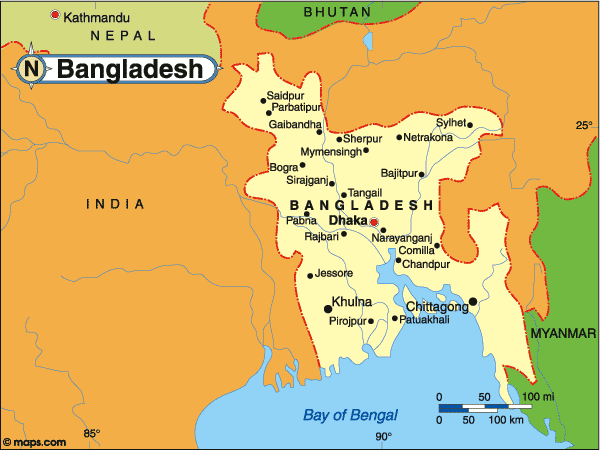
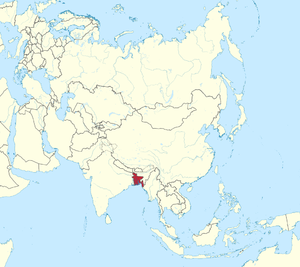
9 From India To Bangladesh: The Train Route That Survived India’s Partition History | TRACKS
13 feb. 2021
IMPORTANT CONTENT
2 jan. 2019
11 Floating farms in Bangladesh help farmers survive floods
14 aug. 2019
12 Floating Gardens
6 nov. 2009
13 How to do Floating Vegetable Garden-step by step
7 feb. 2013
14 Old Dhaka Bangladesh
25 dec. 2019
15 Climate Change in Bangladesh and FRIENDSHIP’s Adaptation Solution
17 mrt. 2016
Climate Change in Bangladesh – A film by Yann Arthus-Bertrand and Anastasia Mikova:
It is the biggest river delta in the world, and it’s a country. Its name is Bangladesh.
There are no real boundaries here between the land and the sea.
Almost 300 waterways cross Bangladesh defining both its geography and its people’s way of life.
From north to south via the capital Dhaka, the country’s 160 million inhabitants among the poorest and most densely populated in the world, have learnt to live surrounded by water and to adapt to its whims.
In the south in the Bay of Bengal, 3 of the planets greatest rivers, the Ganges, the Brahmaputra and the Meghna, discharge every year more than a billion tons of sediment and more water than the all of Europe rivers put together.
Here and for all, it remains the main resource, either for fishing or for agriculture upon which nearly 70% of Bangladeshis. But now the water, this time ally, has become a real threat. Caught between snow melt glaciers of the Himalayas to the north, and the rising waters of the Indian Ocean to the south, residents find themselves overwhelmed by the water. Cyclones, hurricanes, floods, erosion, land, located five meters above sea level, the locally suffers consequences of a global warming of which he is not responsible.
Worse, if global warming continues unabated, Bangladesh could lose up to 17% of its territory from here in 2050. Between 20 and 40 million people would be left without land while underfoot. Walking through Bangladesh to the Bay of Bengal to the south, the “tanks”, these northern precarious islands, through Dhaka or Chittagong, the largest cemetery of ships in the world, the film tells the story of this country, front line of climate change and whose survival hangs by a thread.
Help make a difference. Donate now ► https://friendship.ngo/donate/
Thanks for all your support.
Friendship is an NGO that aims to help poor people in remote and unaddressed communities in Bangladesh.
16 How global climate change is already devastating Bangladesh
23 nov. 2015
17 Bangladesh’s Battle With Water: Can It Save Its Climate Refugees? | Once Upon A River
Back to menu
20 feb. 2021
IMPORTANT CONTENT
18 Climate Change & Child Marriage in Bangladesh (All Parts)
Back to menu
25 okt. 2016
Here are two seemingly unrelated facts: Bangladesh is one of the most vulnerable countries when it comes to the effects of climate change. Around 30% of girls in Bangladesh are married before their 15th birthday.
Hidden Connections is a 20 minute documentary revealing how these two facts are intertwined.
Bristhi and Razia live in Dhaka. Brishti is 14 and works in a garment factory. Her husband’s family has thrown her out because her father hasn’t paid her dowry. Razia is 15 and works as a maid. She lives with her parents but her father worries neighbours will see her talking with boys and wants her married before her prospects are ruined.
Both girls are from families who lost their homes to river erosion. Unable to sustain life in villages, as longer droughts and increased flooding made farming impossible, they came to Dhaka to earn a living. In the film we hear their stories, meet their families and friends, and discover how climate change is pushing social change — and moving things backwards for many girls in Bangladesh.
To learn more about climate change and child marriage in Bangladesh visit: http://www.takepart.com/hidden-connec… . “Hidden Connections” is a joint production of the Thomson Reuters Foundation and TakePart.
At the Thomson Reuters Foundation we act to promote socio-economic progress and the rule of law worldwide. We play a leading role in the fight against human trafficking. We use the skills, values, and expertise of Thomson Reuters to run programmes that trigger real change and empower people around the world. We tackle global issues. We achieve lasting impact.
Read our news: http://news.trust.org/
Learn more: http://www.trust.org/
Follow us on Twitter: https://twitter.com/TR_Foundation
or Facebook: https://www.facebook.com/Thomson.Reut…
We welcome all comments that contribute constructively to the debate. We have the right to remove any posting if, in our opinion, your post does not comply with the content standards set out in the Acceptable Use Policy on http://news.trust.org/.
19 Climate refugees in Bangladesh | DW Documentary
20 mrt. 2019
Within the next 30 years, up to 20% of Bangladesh will disappear beneath the water as rivers and sea levels rise. This will put as many as 30 million people on the move.
Climate researchers say it’s just the first manifestation of a process that will soon be happening all over the world. This film takes us on a journey to the Bangladesh of the future, a country that’s set to suffer terribly from climate change. The Meghna River has already turned into a torrent that’s nine kilometers wide in places, a mass of moving water that flows ten times faster than the Rhine. “It demolished the house I moved into as a bride,” Momtaj Begum says. “It’s where I gave birth to my four children. It breaks my heart.” She and her son are saving what they can before the river sweeps everything relentlessly into the sea. Her village looks like a battlefield. The Meghna has cut deep into the ground, and is literally ripping the soil away beneath the residents’ feet.
Momtaj Begum and her family of eight have already been turned into climate refugees. Her village was swallowed by the river, along with many others. Around 2,000 displaced people like her arrive in the Bangladeshi capital Dhaka every day. With a population topping 20 million and a crumbling infrastructure, the city is on the verge of collapse. The climate refugees that arrive here are now forcibly moved on again, this time by the government. Shantytowns are destroyed by police raids and bulldozers. And what’s happening in Bangladesh is only the beginning. Before long, every country in the world will begin to notice the effects of rising sea levels.
_______
DW Documentary gives you knowledge beyond the headlines. Watch high-class documentaries from German broadcasters and international production companies. Meet intriguing people, travel to distant lands, get a look behind the complexities of daily life and build a deeper understanding of current affairs and global events. Subscribe and explore the world around you with DW Documentary.
20 Bangladesh Documentary climate change
30 aug. 2015
In June 2, 2014, Michael C. Hall travels to Bangladesh to see how climate change will impact workers and the poor in developing countries in the coming decades, when a projected 150 million people will be forced to leave their homes to escape sea level rise and increased drought, insect-borne disease and flooding.
He finds that in low-lying, flood-prone, densely populated Bangladesh, sea level rise and the lengthening of the monsoon season, both caused by global warming, have already caused a migration of coastal people to Dhaka and other cities, and even across the border into India, because they have lost their homes or livelihoods. These factors are projected to lead to the displacement of 20 million of Bangladeshis by 2100, who are often forced to take dangerous work. Hall notes that since the US has contributed a large portion of the emissions already in the atmosphere, it bears responsibility for the climate change impacts in poorer nations.
On June 9, 2014, Hall concludes his journey to Bangladesh, where rising seas are expected to submerge 17% of the country. He learns that global warming is a human rights, public health and foreign policy issue.
21 Climate Migration- Bangladesh on the move
19 feb. 2015
This video documentary explores climate migration in Bangladesh. Footage was filmed on site in Bhola, Chittagong and Dhaka, Bangladesh.
Forced migration is a fact of life for countless Bangladeshis. The mix of factors contributing to migration is difficult to dissect but there appears to be far more “push” than “pull”: movement is typically forced by necessity rather than impelled by opportunity.
Climate change is difficult to isolate as “the” cause of movement but impossible to dismiss as contributing agent. Lack of basic education is a key factor limiting options for daily wage labourers and their respective families, constraining many to struggle for subsistence survival in subhuman conditions in urban slums where vulnerabilities can be more pronounced than problems in rural context communities which triggered the migration in the first place.
As one of three international PhD case studies that deal with climate change related migration, Bangladesh field research sought to assess the contributing role that climate change related problems and rapid onset disasters may have on human movement in the environmental context of densely settled megadeltaic regions.
Conducting grassroots fieldwork across the whole spectrum of human migration or displacement (incorporating both communities of origin and destination), there was a special emphasis on hearing from people directly affected by migration over and above people primarily knowledgeable about them.
In keeping with the intended research questions the case study did not seek to argue for or against the causality nexus between climate change and migration. Rather it conceptualised both present and future forced human movement, including that which may be related to climate change, as causing the least disruption and suffering, if dealt with before its manifestation and possible deterioration into a humanitarian crisis requiring ad hoc emergency intervention.
Forward-planning and preparedness were identified as key success factors for more benign (“less bad”) migration outcomes.
Main findings:
Many migrants would prefer to return to their communities of origin if they had a realistic prospect to find work. This apparent preference makes adaptation and education measures in their communities of origin an important priority. Poverty reduction, livelihood security, education, and better government planning are recommended as essential policy priorities for preparedness informed and more equitable migration management outcomes.
PhD thesis:
The Bangladesh case study can be accessed in Chapter 5 (pp. 167-220) of my thesis:
http://handle.unsw.edu.au/1959.4/52944
22 VLOG Documentary in the Dhaka SLUMS Bangladesh
6 aug. 2018
23 Extreme Poverty – Bangladesh – Short Documentary
24 Life in the shanty towns around Bangladesh’s biggest cities
21 jul. 2015
1. Wide of a slum in Dhaka
2. Wide of entrance into the shanty town
3. Wide of young boy standing in front of his shack
4. Various people in shanty town
5. Close of up a woman and baby
6. Wide of people in the slum
7. SOUNDBITE: (Bangla) Kamrun Naher Ahmed, Programme Officer for Livelihood Security & Risk Reduction, ActionAid:
“You know that Bangladeshi people are increasing day by day. And the people who live in villages are coming into the city because they are not getting enough income and no employment. They think that they will find those in the city, jobs and more money. That’s why they are coming to Dhaka.”
8. Close up of a hand writing on a black broad
9. Mid of children in class
10. Mid of teacher
11. Various of students in class
12. SOUNDBITE: (Bangla) Ismail Hossain, Teacher
“The condition is very bad because parents are not with them during daytime. They have to leave for works. They cannot always take care of their children. No place for kids to play, no place for recreation, also the ared are very densely populated.”
13. Various of children playing
14. SOUNDBITE: (Bangla) Ismail Hossain, Teacher
“Even sometimes mothers make them work. They think that by sending children to school, they wont help families anymore. Instead, if the kids are working, families will have more income and can survive economically.”
15. Mid of watering running into buckets
16. Mid of girl filling a bucket with water and pouring it over her head
17. Wide of woman working in front of her house
18. Mid of rubbish in the polluted water
19. SOUNDBITE:(Bangla) Kamrun Naher Ahmed, Programme Officer for Livelihood Security & Risk Reduction, ActionAid:
“There are many types of problems in slums, like pure drinking water. Even there is a source of water, it’s too little for them, so that’s why they are taking water form rivers or any place they can find. And that generates many diseases.”
20. Various of woman cooking in shack
21. Close young girl eating rice
22. SOUNDBITE:(Bangla) Kamrun Naher Ahmed, Programme Officer for Livelihood Security & Risk Reduction, ActionAid:
“Hunger is also another main problem. Often they can have only one meal a day and for that reason sometime they have to live hunger. This leads to a nutrition problem.”
23. Mid of baby crying
24. Wide of shanty town
25. Mid of a woman washing a crying boy
26. SOUNDBITE:(Bangla) Kamrun Naher Ahmed, Programme Officer for Livelihood Security & Risk Reduction, ActionAid:
“Harassment is also another factor. Also no education so they’re not educated. And girls face different types of harassment.”
27. Close of feet running into a room tilt up to girls running into a room
29. Various of girls playing games in the shelter
30. SOUNDBITE:(Bangla) Laboni (12), young at the shelter:
“Boys used to harass me. And I wasn’t able to take three meals a day. I cannot go to school.”
31. Various of young girls working on sewing machines
32. Various of girls singing and dancing in the shelter
LEAD IN:
Just one mile from the capital city of Bangladesh, Dhaka, large shanty towns house some of the country’s poorest people.
With unemployment rates in the millions, these impoverished Bangladeshis face a hard future.
The solution for many is to migrate to the cities in search of work.
But, massive urban migration has led to a proliferation of slums leading to congestion, unsanitary conditions and disease.
STORYLINE:
Bangladesh is located in the world’s largest river delta – the Ganges delta.
The United Nations Population Fund estimates that Bangladesh has a population of almost 142 million, the largest of the least developed countries in the world.
Just one mile from Dhaka are shanty towns housing the country’s poorest people.
You can license this story through AP Archive: http://www.aparchive.com/metadata/you…
25 Dhaka Extremely Poor People Bangladesh
18 jan. 2020
IMPORTANT CONTENT
26 Made in Bangladesh: Behind the Factory Fire – REWIND
17 okt. 2016
Ten years ago, in November 2006, Al Jazeera English was launched. To mark that anniversary, we’ve created REWIND, which updates some of the channel’s most memorable and award-winning documentaries of the past decade. We find out what happened to some of the characters in those films and ask how their stories have developed in the years since our cameras left.
In November 2012, a fire at the Tazreen Fashions factory in Bangladesh killed at least 112 people. Found among the ashes were the charred remains of garments being manufactured for large US clothing companies.
So why were they being made there, and what do huge multinational corporations do to monitor working conditions in factories like these?
In this Peabody award-winning episode of Al Jazeera’s Fault Lines strand, reporter Anjali Kamat went in search of answers.
Since that report aired, however, worker conditions in factories have been slow to change and industry reforms haven’t been easy.
REWIND revisits that documentary and the underlying issues for factory workers that largely remain today.
28 Exploited garment workers in Bangladesh | DW Documentary
8 mei 2017
29 Made in Bangladesh – the fifth estate
3 okt. 2014
A lot of our clothes bear the label ‘Made in Bangladesh’. But before the deadly collapse of a garment factory there last April, most of us never thought about the people who make them. After clothes bound for Canada were found in the rubble of Rana Plaza, Canadian companies reacted with surprise – how could such a tragedy happen?
the fifth estate’s Mark Kelley went to Bangladesh and tracked down workers who say they are still forced to make clothes for Canada in dangerous conditions. And Kelley goes behind bars for an exclusive interview with the jailed owner of one of the biggest factories inside Rana Plaza, who details his long-standing, multi-million dollar connections to Canada.
Made in Bangladesh won the 2014 International Emmy® Award for Current Affairs programming.
Original airdate : October 11th, 2013
IMPORTANT CONTENT
30 A documentary on ultra poor, titled On a thread – SHIREE
13 dec. 2010
IMPORTANT CONTENT
31 Platform № 5 – Restless Beings Dhaka Street Children
4 mei 2014
32 Bangladesh – Michael C. Hall part 2
30 aug. 2015
33 Flying Into Dhaka – First Impressions of Bangladesh
27 jul. 2017
34 Rickshaw City – Documentary Short
28 nov. 2010
In ‘Rickshaw City’, filmmaker Abu Khan interviews three different Rickshaw drivers through the streets of Bangladesh’s capital Dhaka as they talk about the trials and tribulations of being a rickshaw driver.
Writer, Editor, Producer, Director: Abu Khan
Executive Producer: Marc Lewis
Interviewer, Translator: Saif Ahmed Bhuiyan
Translation, Production Assistant: Kobe
2009
35 Shopping Street Dhaka., Real Dhaka.
9 dec. 2012
36 DHAKA, BANGLADESH: THE MOST FRIENDLY CITY???
00:00 Opening
00:19 Welcome from the Hotel Bengal Blueberry, in Gulshan, Dhaka
00:41 Starting our sightseeing
01:05 The National Parliament Building of Bangladesh
01:32 History of Bangladesh and Bôngobondhu Sheikh Mujibur Rahman
02:30 Making friends on and around a bridge
04:17 Talking about cricket with our new friend
04:49 Lessong in Bengali language
05:33 Kawran Bazar
08:30 Dhaka University and meeting friendly students
10:24 Shaheed Minar Monument
10:59 Faculty of Science, Curzon Hall
11:26 Dhakeshwari Hindu Temple
11:50 Lalbagh Fort
12:05 Old Dhaka
13:07 At water (near Buriganga River)
13:27 Summary / Outro
38 BANGLADESH IS SURPRISINGLY BEAUTIFUL! (incredible floating market)
21 dec. 2019
WHO KNEW Bangladesh was THIS BEAUTIFUL?! Watching the sunrise from our boat as we drifted the floating local market is our favorite memory in Bangladesh.
After spending a couple days in the crazy capital of Dhaka, we took a 100 year old “rocket paddle steamer” boat overnight to the city of Barisal where we woke up before sunrise to catch all the action at the local river market! 

Travel vlog 685 | Country #97/100 | #Barisal, #Bangladesh | Filmed November 29, 2019
39 FIRST IMPRESSIONS OF BANGLADESH (most densely populated city in the world)
15 dec. 2019
12 dec. 2019
 We created FareDrop to help you score super cheap international flights! Try it for free and get flight deals up to 80% off
We created FareDrop to help you score super cheap international flights! Try it for free and get flight deals up to 80% off  https://faredrop.com/
https://faredrop.com/ 
41 FIRST CLASS OVERNIGHT TRAIN IN BANGLADESH (Khulna to Dhaka)
23 dec. 2019
Ready to see the full first class train experience in Bangladesh?
In this vlog, we drive from Barisal to Khulna to catch our overnight #train back to Dhaka, Bangladesh. We booked a #firstclass cabin and just happened to be in a 4 person room, so we give a full tour of our section of the train!


42 We Slept on Bangladesh’s 100 Year Old Cruise Ship (full tour)
18 dec. 2019
We paid $26 to sleep in a First Class Cabin on Bangladesh’s 100 year old “Rocket Paddle Steamer”! Would you do it?
We are currently in our 97th country of Bangladesh, and after spending our first 2 days in the crazy city of Dhaka, we boarded this 100 year old ship to sail overnight to Barisal. Paddle steamers have been traveling Bangladesh’s rivers since the early 1900s, but today there are only 3 left in service. The river is filled with hundreds of modern ferries that are faster and more comfortable, but tonight’s journey isn’t about the speed or the comfort, it’s about experiencing a way of travel that has remained unchanged for almost 100 years!


43 A Silent War (Water Crisis and Flood) made by India in Bangladesh.
44 Bangladesh’s poisoned gift – 101 East
12 aug. 2010
26 jan. 2020
46 Extreme Poverty in Bangladesh: Rebuilding Homes for Slum Residents (Documentary / Real Stories)
24 jan. 2017
47 Mohammadpur Street Children
20 sep. 2017
48 Bangladeshi Village Life 2019
9 aug. 2019
Bangladeshi Village Life 2019
*** Fair Use Disclaimer ***
For Bangladeshi Contents: This channel may use some copyrighted materials without specific authorization of the owner but contents used here falls under the “Fair Use” as described in The Copyright Act 2000 Law No. 28 of the year 2000 of Bangladesh under Chapter 6, Section 36 and Chapter 13 Section 72. According to that law allowance is made for “fair use” for purposes such as criticism, comment, news reporting, teaching, scholarship, and research. Fair use is a use permitted by copyright statute that might otherwise be infringing. Non-profit, educational or personal use tips the balance in favor of fair use.
For USA Contents: This channel may use some copyrighted materials without specific authorization of the owner but contents used here falls under the “Fair Use” Copyright Disclaimer under Section 107 of the Copyright Act 1976, allowance is made for “fair use” for purposes such as criticism, comment, news reporting, teaching, scholarship, and research. Fair use is a use permitted by copyright statute that might otherwise be infringing. Non-profit, educational or personal use tips the balance in favor of fair use.
→ Don’t forget to like, comment and share for all my video or share with your friend about my videos know about Life Time. We love you all !
→Thank you for watching my videos !!
→© NOTICE: All of my videos are owned by my channel . Please don’t re-upload if you don’t want to get any copyright issues
49 Bananasplit – (Ralph inbar) – Dierentuin wagen
50 Fake Money Prank
28 mrt. 2011